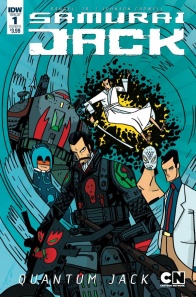Jack came back! And the beloved cartoon had an emotional but satisfying conclusion. Yet it seems the story of Samurai Jack is not over yet, even if we have to dip into a multiverse of Jacks to do so. Is it time for Crisis on Infinite Jacks? Let’s find out!
Written by Fabian Rangel, Jr.
Illustrated and colored by Warwick Johnson-Cadwell
Lettered by Corey BreenA ruthless biker gang ambushes a royal envoy. The name of their leader? SAMURAI JACK! From the team that brought you HELENA CRASH comes an all-new take on the legendary wandering samurai that is completely different and yet surprisingly familiar! Wait, what? How is that even possible? YOU GOTTA READ SAMURAI JACK: QUANTUM JACK TO FIND OUT!
“Samurai Jack” is a classic of animation, and is no stranger to comic book adaptations. This new “Quantum Jack” series, though, takes it in a new direction. We know right from the cover that we’ll be meeting various versions of Jack, including what appears to be a Luchador Jack and a science fiction Jack. Aside from that, though, anything goes, but fans of the series will always be ready for more Jack.
The show has a marvelous style, relying on little dialogue and strong artwork to tell the story, set the scene, and build the mood. The “Quantum Jack” comic does the same, starting off with solid establishing shots, and very little dialogue to accompany the action. Each panel does a fine job telling the story without needing narration to spell it out for us, as it reveals the characters and dives into the action.
The pacing does an excellent job capturing the feel of the “Samurai Jack” show as well, sizing and spacing each panel to speed and slow the flow of action as needed. When things are slow or big, we get nice wide panels to match. When action is fast and sudden, with quick strikes that only last a moment, the panels are smaller and packed together, making each one feel like an instant.
However, the artwork itself is rather different from that of “Samurai Jack,” even though the character designs are similar. While the show features sleek, angular, often geometric artwork as part of its signature look, the “Quantum Jack” comic revels in a more wild look. Warwick Johnson-Cadwell’s artwork is uneven, but intentionally so, with something of an “Oingo-Boingo” inspired look about it.
The style feels very much like an indie comic, where it doesn’t need to be polished to tell the story. In fact, the grungy look serves a purpose to enhance the tone. It creates a bizarre sense, shifting from the usual clean lines we’ve come to expect, because what we’re given in this issue is a very different Jack than the one we know. As Warwick Johnson-Cadwell did the color work as well, the colors match the illustrations exactly as the artist intended, creating a vibrant but bizarre world.
At the same time, the basic designs of the characters still have the same style as we’ve come to expect from “Samurai Jack,” from the animalistic alien forms and geometric character designs to the identical, monochrome robots, it still looks and feels like a “Samurai Jack” comic, even if the style itself is very different.
It’s important to talk about the art style of “Quantum Jack” as the show relied heavily on visual storytelling, and comics do even more so. If there’s less to say about the story, that’s because it’s just getting started, and it takes its time to introduce everything.
“Quantum Jack” lets the story introduce itself to the readers slowly and naturally. It’s an expert example of “show, don’t tell” as it lets us figure out what’s up with this strange biker version of Jack, learn about his character, and see brief flashes of the Jack we know. In doing so, it also builds the mystery of why there is this version of Jack, and how he’s connected to the one we all know.
Although, and this part is a spoiler, I do have to question the logic of Jack waiting until he and his gang have already brought the cryo-frozen child they were hired to steal to the front door of the person who hired them before he revealed he changed his mind and attacked his gang. It probably would have been a whole lot easier to just tell them “Hey, we’re stealing this instead of delivering it” earlier on, then kill them all if necessary (it was), rather than wait until a moment when he’d have to deal with his employer’s killer robots and reveal his betrayal as well.
Continued belowOn the other hand, it led to more fights against a swarm of robots, and presented more unique character designs, so I really can’t complain.
Fabian Rangel clearly has a plan, and choosing to start with the biker gang Jack serves several narrative purposes. Not only do we see a Jack that starts off so very different from the Samurai Jack we know, but in the brief time we get with him, we learn that he’s cunning and has a soft side, in spite of his mercilessness. The brief flashes to Samurai Jack’s past help build the mystery, but it’s only introduced at a point where we’ve already gotten to see this version of Jack in action.
The pacing is methodical, and the storytelling style fits perfectly with that of the cartoon. There’s great synergy between the writer and artist, making it a solid addition to the “Samurai Jack” mythos. This is the start of something unique, and hopefully the beginning of a great tale.
Final Verdict: 7.5 – “Quantum Jack” has a style all its own, while still managing to capture the key elements of “Samurai Jack.” This could be the start of a fascinating tale of the Jackverse.




